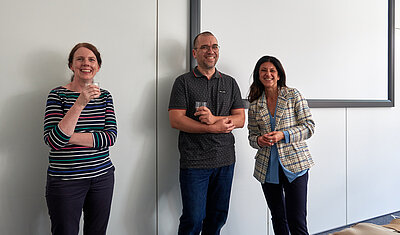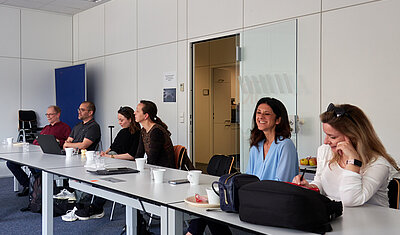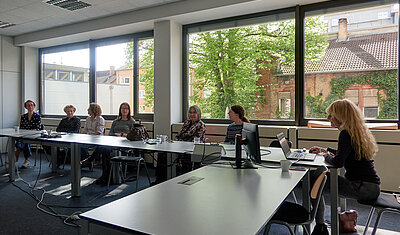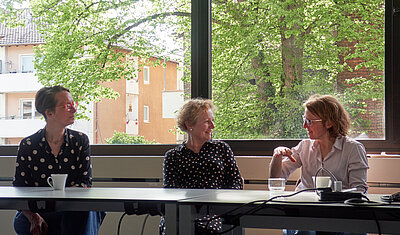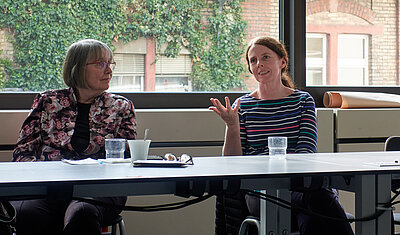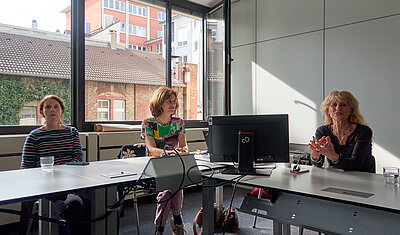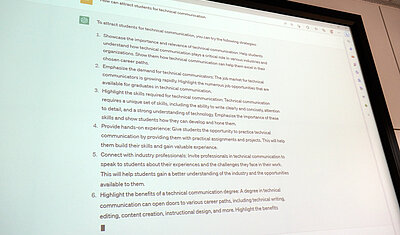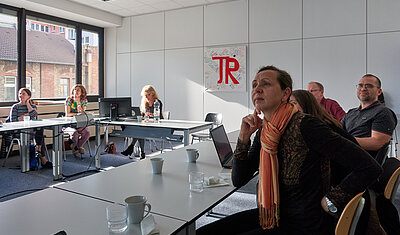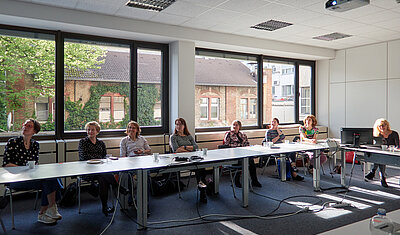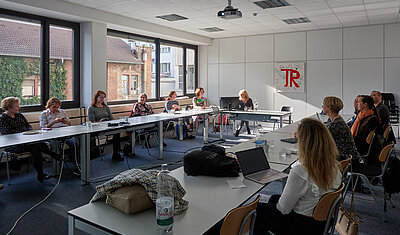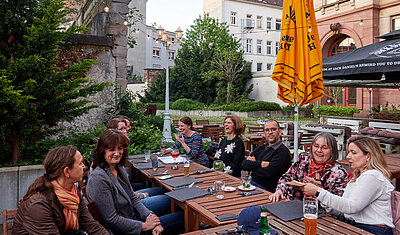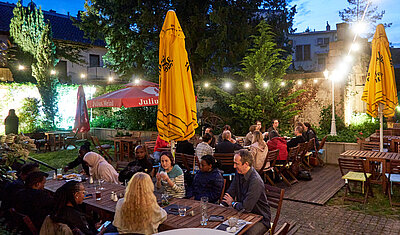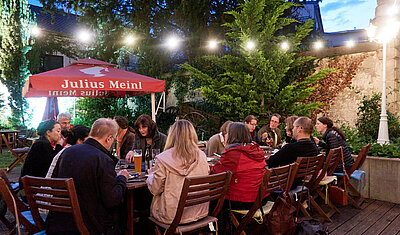Summaries of previous meetings of the IUNTC
What does ChatGPT mean for teaching technical communication?
Results from the first in person meeting of the International Network of Universities in Technical Communication
The first in-person meeting of the International Network of Universities in Technical Communication – IUNTC - took place in the late afternoon of May 4 at Karlsruhe University of Applied Sciences, Germany, preceding the European Academic Colloquium (EAC). About 20 people from all over Europe--university teachers, students and people interested in technical communication-- gathered to discuss important topics about studying and teaching technical communication. It was an excellent opportunity for networking, exchanging ideas, finding project partners and getting to know about the latest trends.
In keeping with the motto for the eighth European Academic Colloquium - the next steps in digital transformation - the question arose as to how ChatGPT will change teaching and learning. Generative AI technologies, such as large language models, have the potential to revolutionize much of our higher education teaching and learning.
May 2023 By Yvonne Cleary & Daniela Straub
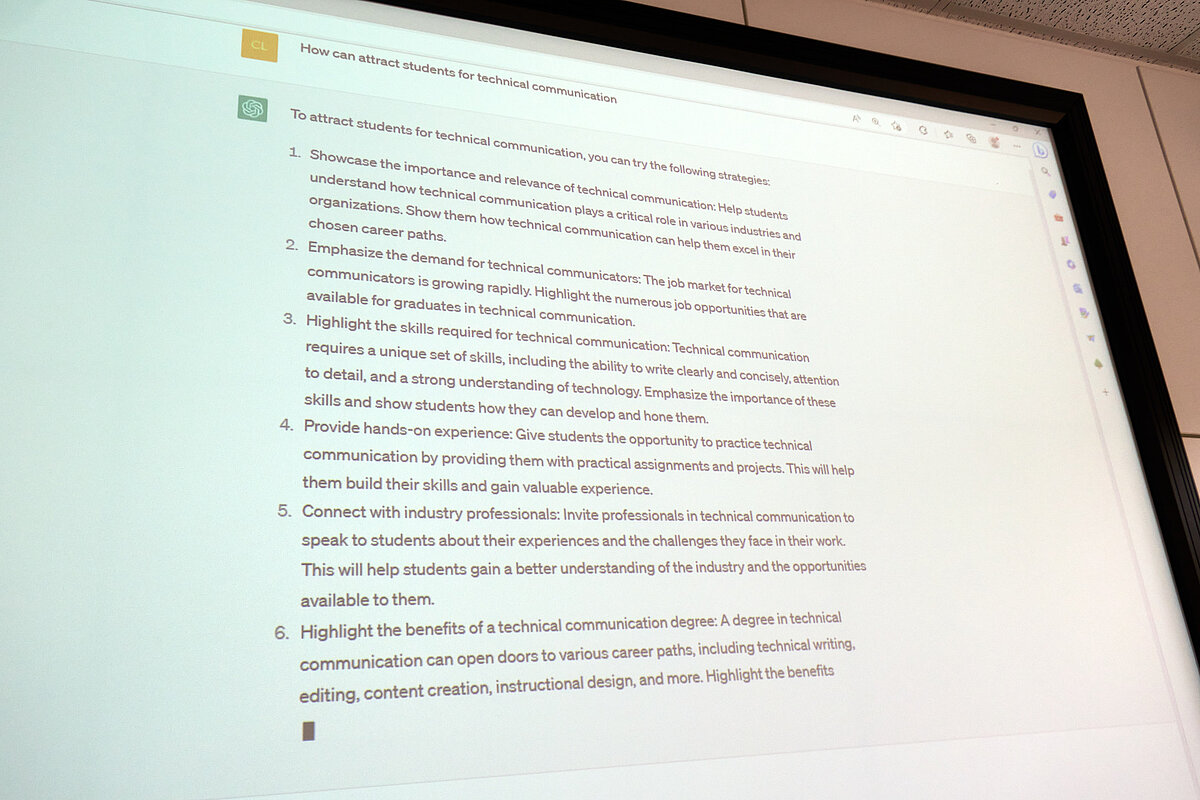
There are many questions to solve, for example from the student‘s perspective, whether they are allowed to use ChatGPT for a seminar or final paper, or whether this practice constitutes cheating? How can they use ChatGPT best? What skills should they acquire, and what skills are obsolete because of ChatGPT? Teachers and lecturers also ask similar questions from a different perspective. They deal with questions like: which skills should be taught and how can students’ competencies be tested rather than their ability to prompt generative AI models. Also, how can ChatGPT and other systems based on generative AI be used to increase the efficiency of developing training, or even improve teaching. Challenges from the teacher‘s side include ensuring students do not simply copy and paste their work from ChatGPT and ensuring that students do not use ChatGPT as a tool for assignments. They have to focus how teaching courses, learning for exams, writing seminar papers and theses, and assessing student learning and performance will change because of the new technology.
In order to improve the participants’ understanding of ChatGPT, we had demonstrations in the meeting. ChatGPT is an artificial intelligence (AI)-based conversational agent that can generate various types of content, including college-level essays. Generative AI systems can generate text, images, or other representations with relatively little human input. They work most effectively when the prompt is precise and specific, so it is really important to formulate a good question, to which ChatGPT then "writes" the answer.
We - the participants of the IUNTC asked ChatGPT if it could write us an opening speech for the following day’s EAC. All participants were amazed at how good the result was. Since this was a vivid experience of how the technologies will also revolutionize technical communication, the group decided to show it at the opening of the EAC - a demonstration of how AI and digitization will change technical communication and teaching.
Hence, it is not surprising that the advent of generative AI fundamentally challenges accepted knowledge, assumptions, and behaviors in higher education. And one thing is also obvious: ChatGPT and GPT-4 are only the forerunners of what we can expect from future generative AI-based models and tools. So it is worth looking into the impact on higher education.
The next IUNTC meeting on Wednesday, 7th of June at 3:00 pm will continue to deal with this topic in detail: AI in academia: balancing benefits and challenges by Jenni Virtaluoto & Prof. Sissi Closs.
Another central question during the meeting was: how can we make technical communication more attractive as a field of study for more students? There was a suggestion on this topic from the University of Munich University of Applied Sciences to find project partners in the community for joint marketing campaigns. The problem that too few students are interested in the courses of study is common across several universities. However, it applies not only to technical communication, but also to other courses of study. In spite of the challenge of recruiting students, technical communication graduates are very attractive for the job market and can expect interesting job offers and a good salary. One challenge is that students may be reluctant to take technical subjects that involve a lot of technology. Current topics such as user experience design or information design may be more attractice. For this reason, many universities are adapting the content of their study programs. In addition, technical communication is not very well recognized as a profession in many countries. Targeted recruitment campaigns would have to start here. In addition, the desired target group - school leavers - is not easy to reach. It´s important to leverage social media and create a social media presence and to showcase technical communication’s relevance and importance which can attract more students who might be interested in pursuing a career in this field. Therefore tekom as the professional organisation for technical communication can help attract more students by providing networking opportunities and marketing campaigns.
The IUNTC meeting ended with a nice dinner together at pleasant summer temperatures in a beer garden in Karlsruhe.
What are the new ways of working for technical communicators?
Kai Weber led the most recent meeting of the International University Network in Technical Communication (IUNTC) on March 23, 2023. He asked about new ways of working for technical writers, as technical communication is undergoing fundamental changes due to automation, digitalization, and globalization. What are the effects of digitalization: How does it change the way we work?
March23 23 Text by Monika Vortisch
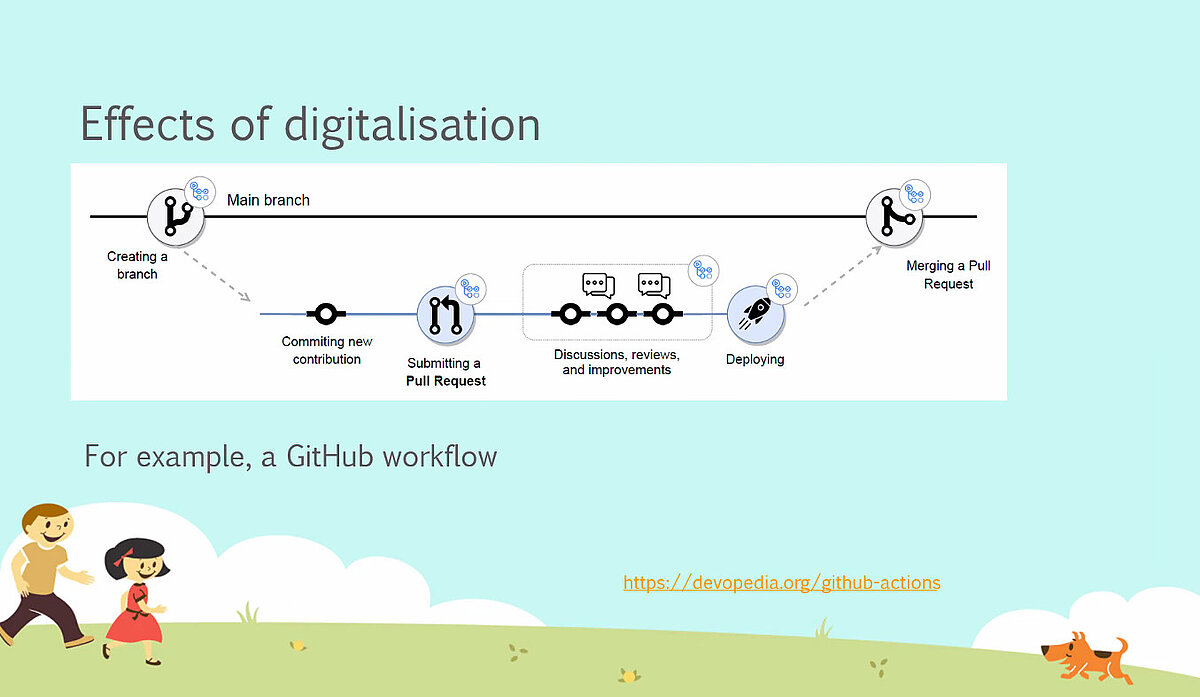
The group discussed what kind of changes technical writers have to deal with nowadays. The participants agreed that the working practices of technical writers have shifted considerably: communication, collaboration and shared learning are highly relevant today.
Communicating in agile teams, applying more frequent, less formal feedback and working in shorter increments of time for rapid or continuous delivery is gaining more and more importance. You must deliver something every day; testing is much shorter and more interactive.
These developments imply that technical writers need to acquire more and different competencies than before. “I was just surprised I had to develop skills I hadn’t before,” said one of the participants.
For technical editors, who used to belong to a separate department, this means a serious change. The backing of the doc team is missing; editors have to work independently and make decisions on their own. As this way of working requires a high level of personal responsibility, it means a big change for employees who are used to hierarchical structures.
The big advantage of agile teams: daily communication in the meetings gives all team members insight into each other's work. Technical writers often get direct feedback on their documentation and can then adjust it to improve the user experience.
Video conferencing or web meetings are extremely important for editors, as they usually have no access to the development environment and must rely on being part of the information flow.
In the context of agile development, only a few specifications are still available to editors as a source of information. Therefore, a good document management system helps to manage documents. Most technical writers see this as an advantage: products and their documentation are tested in a timely manner so that errors are discovered more quickly, and the editors' work can be assessed.
When working according to the waterfall principle, developers often have no way of recording their meetings with editors in terms of time. In Scrum mode, the creation of individual texts is a backlog item, which also strengthens the position of the editor in the team. A key takeaway from the meeting was that technical writers must have an open ear; their documentation might otherwise fall out of step. IUNTC participants thanked Kai for his interesting and insightful presentation.
Kai Weber is a lead technical writer for financial and banking software, SimCorp GmbH. He is a long-standing member of tekom and a regular conference speaker.
How to integrate research into the TC curriculum: an experience report and some lessons learned
Applied research is important: for supporting the practice of technical communicators and information designers, but also for the identity of the field. The high teaching load at universities of applied sciences, where programs of study for technical communication and information design are usually found, still leaves little leeway for research. In this context, Dr. Michael Meng, Professor of Applied Linguistics at the University of Merseburg, refers to the importance of impulses from teachers in order to advance research.
Dec.15 22 Text by Monika Vortisch

The general goals
“We have a research gap in Germany. For this reason, we need more graduates who are interested in research,” Dr. Michael Meng, Professor of Applied Linguistics at Merseburg University of Applied Sciences, said at the last IUNTC meeting on December 15. He has been working since 2012 in the department of economics and information technology at at Merseburg University of Applied Sciences, researching in the fields of technical communication, information design and psycholinguistics.
The professor sees the main reasons for this, among other factors, as the lack of time in universities of applied sciences. With 16 to 18 hours of teaching obligations, it is difficult to build and lead a research group. “However, it is also important to do more at universities to introduce students to research,” says Dr. Meng. The role and importance of research, according to Dr. Meng, must be demonstrated in order to spark students’ interest and allow them to actively collaborate. Teachers should continually ponder how to introduce students to research, interest them in it and enable them to conduct research.
For this purpose, a module of 4 semester hours per week (a total of 150 hours) was integrated into the third semester of the “Information Design and Media Management” master’s degree program at the University of Merseburg, dedicated to research and research methods specifically and exclusively.

Core contents of the module
Part 1 includes teaching the role and importance of research, general goals and approaches, the structure of research projects, how to proceed with quantitative, qualitative, and mixed-method studies, and the evaluation and presentation of results;
Part 2 includes planning and implementing a small research project in groups of 4-5 students and presenting it as a conference poster.
The central document and basis for planning the content and designing the exercises is Hayhoe & Brewer’s book “A Research Primer for Technical Communication” (2nd edition, 2021, Routledge, New York. DOI: https://doi.org).
What research topics do students work on in this module?
“Topics for student research projects are sometimes developed in cooperation with businesses. Other topics are oriented to studies from earlier research, attempting, for example, a complete or partial replication. Very frequently, however, students work on a topic they have freely chosen themselves,” explains Dr. Meng. The central challenge is, however, limiting the topics, as only a limited period of 15 weeks is available, and choosing a research design that can be realized within a semester.
According to Dr. Meng, the offering has been well received. The results are actually always of good or very good quality; exciting topics are found and worked on. “Now, we are hoping that one or another can also be found who would like to deepen their interest in research after completing the master's degree and take the path to a doctorate, for example in a doctoral center at the University at Merseburg!”
Please contact Prof. Michael Meng with any questions at the following email address: michael.meng@hs-merseburg.de
Master’s in Communication and Media: Introduction of a New Study Discipline at Pwani University in Kenya
Promoting the academic discipline of technical communication through international cooperation, leading to the development of a Master’s in Communication and Media at a university in Kenya, was the subject of the most recent IUNTC meeting on October 25th, 2022. The meeting was led by Professor Sissi Closs and Belinda Oechsler from the University of Applied Sciences, Karlsruhe (HKA), joined by colleagues from Pwani University (PU), Kenya--Edith Miano, Dr Rukiya Swaleh, Dr Elizabeth Munyaya, Alex Muthanga, and Prof. Yakobo Mutiti--and Dr Yvonne Cleary from the University of Limerick (UL), Ireland.
Oct. 20 22 Text by Yvonne Cleary

This project has a history dating back to 2014, when Professor Closs initiated an exchange project between HKA and PU. This project was called ADDI – ADaptive Digital Learning System. The focus was on Communication and Media, live student exchanges between HKA and PU, and the development of a digital platform to share content and collaborate: karlifi.org.
When in-person exchanges became impossible in 2021 due to the pandemic, a new project was initiated to enable virtual exchanges: VIEL (Virtual Intercultural Exchange and Learning). A third partner was included, UL. Students at the three universities get to know one another in weekly meetings online, attend workshops, and complete small group assignments (like making podcasts and short videos). Students receive a certificate and get to meet at one of the participating universities if no travel restrictions are in place. To-date, VIEL students and staff have met in Kenya (February 2022) and Ireland (July 2022). Both ADDI and VIEL were funded by BWSplus (the Baden-Württemberg-STIPENDIUM for University Students, a programme of the Baden-Württemberg Stiftung).
A third project in this cycle and by far the most ambitious, MCM (Master’s in Communication and Media) is funded by the DAAD (Deutscher Akademischer Austauschdienst –German Academic Exchange Service). Its goal is to introduce a new study programme in the discipline of technical communication at PU. The project includes various stages: curriculum development, accreditation of the programme at PU, implementation of a suitable IT environment and equipment, staff training, marketing of the programme in Kenya, and the establishment of a network to get support from local companies and to connect them with programme staff, students, and graduates.
Following a live kick-off event at PU in September 2022, a pilot programme is already underway with 12 students from PU taking Special Courses in Communication and Media. The pilot involves 11 external teachers, with most classes delivered virtually but some on-site. It is a very important phase in the project because the feedback from students and teachers will shape the delivery of the Master’s in Communication and Media, due to start in Autumn/Winter 2023.
The various connected projects have been successful because of funding from BWSplus and DAAD, a stable project team, excellent leadership, a high level of commitment on the Pwani side, and growing interest from students and lecturers.
To learn more about the projects, or to get involved, see:
Master’s in Communication and Media Website: mcmstudy.org
Karlifi Learning Platform: karlifi.org
Technical Communication Teaching Projects: Virtual Exchanges with the TAPP Project
Suvi Isohella from the University of Vaasa in Finland led a very engaging and well-attended session on the TAPP project, which supports international inter-institutional student projects in technical communication.
September 29 22 Text by Yvonne Cleary and Suvi Isohella

Collaborative international inter-institutional projects offer immense benefits for technical communication students and teachers. Students learn first-hand about the challenges and rewards of collaboration, virtual exchange, and intercultural communication. They also develop transferable skills that help to prepare them for the workplace. Teachers experience new and dynamic pedagogical approaches, and successful projects may lead to research, as well as teaching, partnerships. While many institutions encourage international inter-institutional exchanges because of these and other benefits, establishing contacts and projects is time-consuming and complex.
On Wednesday, September 21st, during the first International University Network in Technical Communication (IUNTC) meeting after the summer break, Suvi Isohella, University Teacher in Technical Communication at the University of Vaasa in Finland, led an engaging and informative discussion about the Trans-Atlantic and Pacific Project (TAPP). Suvi explained how TAPP supports international inter-institutional exchanges in technical communication.
The TAPP network was established in 1999/2000 by Dr Bruce Maylath and Dr Sonia Vandepitte. What began as an exchange between two universities has since grown to a network of 49 universities in 21 countries across five continents. The network coordinator maintains a database of project partners and project types, and helps individuals to find suitable partners, and to establish and run projects.
Suvi described three types of project supported by TAPP.
- Writing-translation projects, where writers prepare a source text for translation, and translators localise the text for the target audience.
- Bilateral translation-editing projects, where translators get feedback from editors about their translations (usually into English, which is not their first language).
- Multilateral projects, that reflect the workplace norm of cross-functional collaboration.
Students at the University of Vaasa have been involved in several multilateral projects since 2010. The Vaasa students have focussed on usability testing in many of these projects. For example, as illustrated in the figure below, they have worked with students from universities in Spain and the US to write, translate, and test instructions. They have also worked on multilateral projects to develop personas, and to create infographics.
Suvi explained that TAPP projects are successful because they are administratively uncomplicated. Projects do not depend on funding, and the teachers collaborate to design assignments that match their modules and learning outcomes. Of course, as with any inter-institutional collaboration, teachers must take several steps to ensure projects are successful. Students need detailed instructions and scheduling can be complicated, especially when multiple institutions are involved.
Suvi’s talk concluded with a lively discussion and question and answer session. This IUNTC meeting, like many others, was very well-attended and included participants from all over the world. Several members of TAPP were present, including Dr Patricia Minacori, Dr Bruce Maylath (outgoing coordinator) and Dr Ashley Petts (coordinator since August 2022).
You can learn more about TAPP and how to get involved, at: The Trans-Atlantic and Pacific Project | University of Houston-Downtown (uhd.edu).
Find the presentation slides here.
How do YOU search for existing knowledge?IUNTC Meeting Explores Search Strategies in Technical Communication
Dr Kim Sydow Campbell led the most recent meeting of the International University Network in Technical Communication (IUNTC) on June 14th, 2022.
In this meeting, Kim explored this question: “How do YOU search for existing knowledge?” This is an important question for researchers, who need to be sure they have access to the breadth of published research about a topic. It is an important question for industry practitioners, who need to ensure they can access the most up-to-date information for their work projects and practice. And it is an important question for teachers, who need to help students develop systematic and comprehensive search strategies.
June14 22 Text by Yvonne Cleary
During the first half of the meeting, Kim provided some background to the topic. Researchers in some fields (e.g. medical researchers) use a standard methodology for systematic literature reviews. Those reviews are then available as guidance to practitioners. In contrast, researchers in Business, Professional, and Technical Communication (BPTC) tend to have less systematic approaches when conducting literature reviews. They use multiple databases and, because of the expanding range of journals, they do not always know the extent and focus of recently published work. They conduct integrative literature reviews infrequently, and these are rarely available to practitioners. Thus, there is relatively little research-based guidance for BPTC researchers. There is also a lack of shared knowledge between academics and industry practitioners, and a lack of understanding about how trade publications and other industry sources are used in practitioner and academic research.
The second half of the meeting involved a lively and rich discussion among participants, both industry practitioners and academics, about our literature search methods. Some themes that emerged from that discussion included: learning from other disciplines like medicine, where the PRISMA framework is an accepted standard; the importance of including international journals in our searches; and the variety of sources with up-to-date content, including blogs, conferences, and dissertations. A key takeaway from the meeting was the need for shared guidance about where knowledge is held and how to access it.
Dr Kim Sydow Campbell is Professor of Technical Communication at the University of North Texas, USA. She has published several books and book chapters, and more than 40 peer reviewed journal articles. She was editor-in-chief of the IEEE Transactions on Professional Communication journal from 1998 to 2008. She is the recipient of multiple awards. This year, she was awarded the Society for Technical Communication’s Jay R. Gould Award for Excellence in Teaching Technical Communication.
How important is localizing user documentation?
A report from the latest meeting of the International University Network in Technical Communication (IUNTC)
May20 22 Text by Yvonne Cleary and Daniela Straub
Because markets for technical products have globalized, it is essential to consider the impact of cultural preferences on the usability and user experience of user instructions.
On Thursday, May 12 over 50 participants joined the latest meeting of the IUNTC, led by Dr. Joyce Karreman, Assistant Professor of Technical Communication at the University of Twente in the Netherlands. Joyce’s presentation was entitled ‘How important is localizing user documentation? Research on the effects of localization on users.’ The presentation discussed a series of experiments Joyce and her colleagues, Qian Li and Menno de Jong, have conducted to explore how Chinese and Western user instructions differ, and to determine the effects of cultural adaptations on Chinese and Western users.
The first study Joyce described was a content analysis of 50 Western and 50 Chinese household manuals. The analysis confirmed previous research findings that demonstrated differences in content, structure, and visuals. In terms of content, Joyce and her colleagues found that Western user documentation tends be highly instrumental: its purpose is to explain to end users how a device works. Chinese manuals are likely to be less purposeful and more entertaining. Chinese user documentation is not only meant for end users, but also for technicians, and may contain marketing as well as procedural information. Western documentation tends to be highly structured, e.g. using levels of headings, chunking, and lists. In contrast, in typical Chinese documentation, heading levels and lists are less likely to be consistent or prominent. Instructions may be presented in paragraphs rather than lists. Chinese manuals present expository information in an inductive structure (arguments first), whereas Western manuals present expository information in a deductive structure (conclusion first). In terms of visuals, again, Western instructional documents are functional, and visuals (e.g. technical drawings) are meant to clarify how a device works. In Chinese user documentation, cartoons and other entertaining or diverting visuals are used.
In a related study, Joyce and her colleagues interviewed twenty Chinese technical communicators, to explore their opinions about differences between Chinese and Western user documentation. The interviewees recognized the importance of culture and the different expectations of Western and Chinese users. They believed that Western users rely more on user documentation than Chinese users. Because the interviewees used style sheets and standardized tools, the research team concluded that Chinese manuals may become more like Western manuals in the future.
Joyce also described three user studies designed to explore the effects of Chinese and Western approaches to structure, expository information, and visuals. These studies were conducted with three participant groups: Chinese people based in China, Chinese people based in Europe, and Westerners based in Europe. The results of the study on document structure showed no significant differences in task performance or perceived usability. In the second study, examining the structure of expository text, both groups of Chinese participants preferred expository text presented inductively (with arguments first) for both readability and persuasiveness, while Western participants preferred information presented deductively. The third study examined the use of various types of cartoons and technical line drawings. The results were largely in line with expectations, that Chinese participants appreciated entertaining visuals while Western participants reacted more positively to technical visuals.
The overall conclusion of this work is that localization improves the user experience, but may not be essential for the usability of user documentation.
A lively question and answer session followed the talk, with questions and comments about how the studies had been conducted, demographics of participants, follow-up research, the hidden impact of culture, and an array of other topics. IUNTC participants thanked Joyce for her interesting and insightful presentation.
The next IUNTC meeting will be on Tuesday, June 14 at 15.00 (Central European Summer Time). Professor Kim Sydow Campbell from the University of North Texas will lead this meeting, entitled: “How do YOU search for existing knowledge? Listening to academics and practitioners in business/professional/technical communication across the globe”.
Further reading
Li, Q., De Jong, M. D. T., & Karreman, J. (2020). Cultural differences between Chinese and Western user instructions: A content analysis of user manuals for household appliances. IEEE Transactions on Professional Communication, 63(1), 3-20.
Li, Q., Karreman, J., & De Jong, M. D. T. (2019). Chinese Technical Communicators' Opinions on Cultural Differences between Chinese and Western User Manuals. ProComm 2019, IEEE International Professional Communication Conference, July, Aachen, Germany.
Li, Q., De Jong, M. D. T., & Karreman, J. (2021). Cultural differences and the structure of user instructions: Effects of Chinese and Western structuring principles on Chinese and Western users. Technical Communication, 68(1), 37-55.
Li, Q., Karreman, J., & De Jong, M. D. T. (2020). Inductively versus deductively structured product descriptions: Effects on Chinese and Western readers. Journal of Business and Technical Communication, 34(4), 335-363.
Li, Q., De Jong, M. D. T., & Karreman, J. (2021). Getting the picture: A Cross-Cultural Comparison of Chinese and Western Users’ Preferences for Image Types in Manuals for Household Appliances. Journal of Technical Writing and Communication, 51(2), 137-158.
Trends and demands in specialized technical communication
"New job profiles and new job titles in technical communication – how much agile project management does technical communication need?" This was the topic of the sixth online meeting of the International Network of Universities in Technical Communication (IUNTC).
March 2022 Text by Daniela Straub

Thirty-three participants joined the meeting, which started with an interesting lecture by Dr. Christiane Zehrer on “Agiles Methods and their meaning in todays working world”. Dr Zehrer is an agile practitioner (Certified Scrum Master) and a technical communication instructor at Hochschule Magdeburg-Stendal, Germany.
Currently, around 27.3 percent of employees in technical communication in Germany work in software companies. About three percent of all employees in a software company are technical writers. Software industry is a growing segment, with a growing ratio of technical writers in business units.
The work of technical writers in software development differs significantly from other industries. For one thing, they use other tools, e.g. component content management systems are less common in software development than in other industries. They also create other types of information for use, e.g. API (Application Programming Interface) documentation and embedded help. In addition, there is the digitization trend: With growing digitization, products, business models, value chains, customer behavior, and the workplace change. This also leads to radical changes in the work of technical communicators. As an example, agile project management methods are already common in most software companies, leading to a stronger interlink between product development and technical communication.
A Mentimeter survey of meeting participants showed that most are already familiar with agile project management methods, especially Scrum and Kanban. In contrast to classic project management, agile methods differ mainly in the shorter and more detailed planning phases. Task packages are kept as small as possible and scheduled for a fixed time. For example, daily standups are fixed elements: Teams coordinate their work through frequent, but usually short meetings. Sprint backlogs – a prioritized list of all those functions that are due at the end of the respective work period – are another important agile element. They consist of user stories, which describe the product from the user's point of view and focus on the task that the user wants to do. This provides a different perspective on the product. User stories are further devided into tasks, functions are secondary. User stories and tasks are usually visualized using material or a virtual agile board.
Thus, technical writers, who work in the software industry, are an integral part of the agile development process. The question in the group was whether employees of technical communication, especially in software development, need new skills such as training in agile methods, and whether the future would see an increased need for generalists or specialists. These questions were discussed in breakout rooms.
As a conclusion, the following was noted: Project management, time management, und team communication will play a particularly central role in future. Also technological trends for context-based information delivery are becoming increasingly important. So technical competencies will be required in the future, e.g. to be able to read code for testing and user experience design. But above all, skills in interpersonal communication are still essential. The self understanding as a technical writer changes to the “information developer”.

